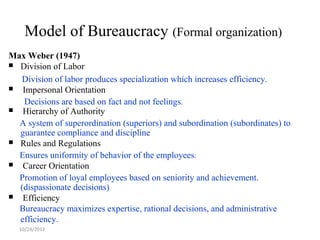Structure in schools hoy n miskel
- 1. Structure in Schools Hoy and Miskel, 2008 10/24/2012
- 2. Model of Bureaucracy (Formal organization) Max Weber (1947) Division of Labor Division of labor produces specialization which increases efficiency. Impersonal Orientation Decisions are based on fact and not feelings. Hierarchy of Authority A system of superordination (superiors) and subordination (subordinates) to guarantee compliance and discipline Rules and Regulations Ensures uniformity of behavior of the employees. Career Orientation Promotion of loyal employees based on seniority and achievement. (dispassionate decisions) Efficiency Bureaucracy maximizes expertise, rational decisions, and administrative efficiency. 10/24/2012
- 3. Weber’s Model of Bureaucracy in Popular TV He has the office on top floor- highest source of authority Charismatic authority rules and regulations – stable and without personality- even when seduced by a beautiful woman, he remains incorruptible MAD MEN (TV series) 10/24/2012 Cooper Draper Pryce is the incarnation of Weber’s bureaucratic model Sterling
- 4. Critique of Weber’s Model 1. Dysfunctional aspects are not considered 2. Informal organization is neglected 3. Dual structure of bureaucratic model 4. Feminist critique 10/24/2012
- 5. Dysfunctional Features of Bureaucracy Function Characteristic Dysfunction Expertise Division of Labor Boredom Rationality Impersonal Orientation Lack of morale Compliance and Hierarchy of Authority Communication Coordination blocks Continuity and Rules and Regulations Rigidity and goal Stability displacement Incentive Career Orientation Conflict between achievement and seniority 10/24/2012
- 6. Functions and Dysfunctions of Rules Functions Dysfunctions Explication Reinforce Apathy(minimum acceptable ) Screening (buffering) Goal displacement Legitimate Punishment Create legalism Leeway Indulgency (leniency) 10/24/2012
- 7. Informal Organization- “Shadow Organization” It is the spontaneous development of a social structure and culture within a formal organization How does it develop within a formal organization? Personal relations Division into cliques (based on feelings, common lounge, age, similar interests, etc) Social norms (appropriate behavior) Informal roles( unofficial spokesperson, informal leaders) Informal communication(the grapevine) 10/24/2012
- 8. Dual Structure of the Bureaucratic Model Is bureaucratic administration based primarily on expertise, or is it based on rules and discipline? The answer to this question creates the conflict of dual bureaucracy in Weber’s model. 10/24/2012
- 9. Feminist Critique Bureaucracies promote male values at the expense of female ones. Hierarchy Equalitarian Impersonality personalized VS. Independence dependence Competition Cooperation Rationality Emotionality 10/24/2012
- 10. Structure in Schools -HALL Two Types of Rational Organizations rather than One integrated model -Hall(1962) Bureaucratic Pattern Hierarchy of Authority Rules for employees Procedural Specifications Impersonality Professional Pattern Technical Competence Specialization 10/24/2012
- 11. Formal Structure in Schools Professional Pattern High Low High Weberian Authoritarian Bureaucratic Pattern Low Professional Chaotic 10/24/2012
- 12. Predicted Changes In School Structure Chaotic Authoritarian Weberian Professional Organization Organization Organization Organization Stable Environment Turbulent Environment 10/24/2012
- 13. Structure in Schools –Hoy and Sweetland (2000-2001) School structures can be described along a continuum from enabling to hindering. Enabling School Structure Hindering School Structure Enabling Hierarchy Hindering Hierarchy Enabling formalization (rules & Coercive formalization (rules procedures) &procedures) Use Impose top-down two-way communication communication View problems as View problems as opportunities constraints Seek mutual solutions Force consensus Support differences Suspicious of differences Practice openness Be cautious and closed Embrace the unexpected Fear the unexpected Correct mistakes Punish mistakes 10/24/2012
- 14. Key Parts of Structure- Mintzberg Strategic superintendent over a school district Apex Coordinators- Accountant-maintenance instructional supervisors Techno- Middle Support Structure Line Staff School principal Operating Core teachers 10/24/2012
- 15. Coordinating Mechanisms-Mintzberg They are the fundamental means organizations use to monitor and control work. These mechanisms are the glue the hold the organization together. Mutual Adjustment--informal communication Direct Supervision--personal command Standardization of Work– work program directions Standardization of Output--specify work results Standardization of Skills--specify training 10/24/2012
- 16. Five Combinations and Five Basic Structures (Mintzberg) Strategic Apex Directive Supervision Simple Structure Technostructur Stand. of Work Machine Bur. e Stand. of Skills Professional Bur. Operating Core Stand. of Outputs Divisional Form Middle Line Mutual Adjustment Adhocracy Support Staff 10/24/2012
- 17. Loose Coupling Perspective Loose couplings are structural connections among school units in the bureaucratic structure. Ex. the administration of a school has little influence on what is happening in the classroom. Schools are complex organizations with both tight and loose structural connections. Bureaucracies tend to be tightly structured. Professional organizations tend to be more loosely structured. Tight coupling promotes limits discretion of teachers. Loose coupling enhances discretion of teachers. 10/24/2012
- 18. Professional and Bureaucratic Orientations Professional Orientation Bureaucratic Orientation Sources of Compatibility between Orientations • Expertise • Expertise • Objective perspective • Objective perspective • Impersonal approach • Impersonal approach • Service to clients • Service to the organization Sources of Conflict between Orientations • Colleague reference group • Hierarchical orientation • Autonomy in decision making • Disciplined compliance • Self-imposed control • Subordinated to the organization 10/24/2012


















